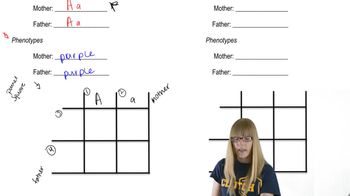Table of contents
- 1. Introduction to Genetics51m
- 2. Mendel's Laws of Inheritance3h 37m
- 3. Extensions to Mendelian Inheritance2h 41m
- 4. Genetic Mapping and Linkage2h 28m
- 5. Genetics of Bacteria and Viruses1h 21m
- 6. Chromosomal Variation1h 48m
- 7. DNA and Chromosome Structure56m
- 8. DNA Replication1h 10m
- 9. Mitosis and Meiosis1h 34m
- 10. Transcription1h 0m
- 11. Translation58m
- 12. Gene Regulation in Prokaryotes1h 19m
- 13. Gene Regulation in Eukaryotes44m
- 14. Genetic Control of Development44m
- 15. Genomes and Genomics1h 50m
- 16. Transposable Elements47m
- 17. Mutation, Repair, and Recombination1h 6m
- 18. Molecular Genetic Tools19m
- 19. Cancer Genetics29m
- 20. Quantitative Genetics1h 26m
- 21. Population Genetics50m
- 22. Evolutionary Genetics29m
2. Mendel's Laws of Inheritance
Monohybrid Cross
Problem 11a
Textbook Question
Black skin color is dominant to pink skin color in pigs. Two heterozygous black pigs are crossed.
If these pigs produce a total of three piglets, what is the probability that two will be pink and one will be black?
 Verified step by step guidance
Verified step by step guidance1
span>Step 1: Identify the genotypes of the parent pigs. Since black skin color is dominant and the pigs are heterozygous, their genotype is Bb, where B represents the dominant black allele and b represents the recessive pink allele.</span
span>Step 2: Determine the possible genotypes of the offspring using a Punnett square. Cross Bb (black) with Bb (black) to find the genotypic ratio of the offspring.</span
span>Step 3: Calculate the probability of each genotype. From the Punnett square, the genotypic ratio is 1 BB : 2 Bb : 1 bb. Therefore, the probability of a black piglet (BB or Bb) is 3/4, and the probability of a pink piglet (bb) is 1/4.</span
span>Step 4: Use the binomial probability formula to find the probability of having exactly two pink piglets and one black piglet. The formula is P(X=k) = C(n, k) * (p^k) * ((1-p)^(n-k)), where n is the total number of piglets, k is the number of pink piglets, p is the probability of a pink piglet, and C(n, k) is the binomial coefficient.</span
span>Step 5: Substitute the values into the formula: n = 3, k = 2, p = 1/4. Calculate the binomial coefficient C(3, 2) and substitute into the formula to find the probability.</span
Recommended similar problem, with video answer:
 Verified Solution
Verified SolutionThis video solution was recommended by our tutors as helpful for the problem above
Video duration:
2mPlay a video:
Was this helpful?
Key Concepts
Here are the essential concepts you must grasp in order to answer the question correctly.
Mendelian Genetics
Mendelian genetics is the study of how traits are inherited through generations based on the principles established by Gregor Mendel. It involves understanding dominant and recessive alleles, where dominant alleles mask the expression of recessive ones. In this case, black skin color is dominant over pink, meaning that a pig with at least one black allele will exhibit black skin.
Recommended video:
Guided course

Descriptive Genetics
Punnett Square
A Punnett square is a diagram used to predict the genetic outcomes of a cross between two organisms. By organizing the alleles of the parents, it allows for the visualization of possible genotypes and phenotypes of the offspring. For the cross of two heterozygous black pigs (Bb x Bb), the Punnett square helps determine the probabilities of producing black and pink piglets.
Recommended video:
Guided course

Chi Square Analysis
Probability in Genetics
Probability in genetics refers to the likelihood of certain traits appearing in offspring based on parental genotypes. In this scenario, the probability of producing specific combinations of piglets can be calculated using the ratios derived from the Punnett square. For example, the likelihood of getting two pink and one black piglet from the total offspring can be determined using binomial probability formulas.
Recommended video:
Guided course

Probability

 1:20m
1:20mWatch next
Master Monohybrid Cross with a bite sized video explanation from Kylia Goodner
Start learningRelated Videos
Related Practice


